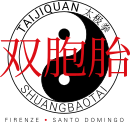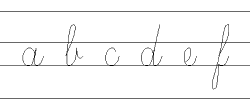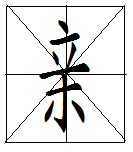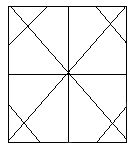



anti-fascist
anti-racist

|
   |
anti-sexist anti-fascist anti-racist |
The study of the Chinese calligraphy has opened me a window on my way of teaching taijiquan to my students. In fact I have started to think that the understanding of the right position of the body in the space is of difficult comprehension for us the Westerners because we are accustomed to think in linear way, at most in four directions: forward – back– above – below. Thinking in eight directions is very uncommon for us. We are not trained to do it.
Indeed the first great trainings that we face as children is learning how to read and write.

In the West we read after learning how to recognize and combine a sound to the letters of the alphabet, following a direction, from left to right; we learn how to write by tracing the various letters of the alphabet between the guidelines, always in the left-right direction. The guidelines traced in the pages of school exercise books of the first elementary classes determine the space where we insert the various letters, and our letters are, usually, all included between two lines, except for some that are raised in the superior space and other that are lowered in the inferior space.

A Chinese child needs much more time in such training, because in order to be able to read he has to learn to recognize every single character, combine it with its meaning and with its pronunciation; In order to write he has to learn in which direction he has to trace the various strokes, in which position in the reference square, in which order in the composition of the character, how much pressure he needs to apply while drawing every single stroke.
The exercise book of a Chinese child in the first school years is divided in squares with diagonal and median lines, that determine the space and the directions to trace the various characters. And this is an excellent training for the perception of the space around himself.
Since we are being less trained as children, we the Westerners require a particularly great attention on the directions that our body has to employ. For this reason I ask my students to imagine themselves included in a square with median and diagonal lines in the first lessons of taijiquan, and to move being aware of the direction and position of their limbs. The importance attributed to the position in the space while executing the form is fundamental for the coordination of body's movements and for a better balance. Therefore having personal and sure reference points is very important for the students.
I have noticed that my request of imagining themselves as included in the center of a square, as if they were a Chinese character, well written, works quite well with my students.

Later, when we have built the basis a little bit, and their legs have got stronger, I ask them to imagine themselves as if included in an octagon, as in the wonderful Saint John, the baptistery of Florence. In fact very often when I ask them to take a bow stance towards the right corner, I have noticed that it is better if I specify to maintain the direction of the body parallel to the imaginary wall of the octagon, formed by the cord of the angle, in order to avoid that their body is all lined up on the diagonal and unbalanced on the right.
Generally the practice happens in rectangular gyms or rooms, therefore directing the body in the four directions results quite simple, but when one has to go in the eight directions, the hint of visualizing the imaginary walls that cut the angles perpendicularly to the diagonals and form the octagon is of great help. When the practice happens in the open space, finding a certain reference point and imagining an octagonal space starting from it becomes absolutely necessary.

I start to stress on this requirement when we start the second part, to “Embrace the Tiger and Return to Mountain”. Once the position has become automatic, it is very useful in all the sequence of the form; just think of “Jade Lady Passes Through the Shuttle”; and it becomes even more precious mostly while executing the saber and sword forms, in which all the movements in the space should happen in a secure and automatic way, since there’s no time to think about where or how to position oneself.

The photo of the Florence baptistery is distributed based on the GNU Free Documentation License, by voice of Wikipedia: Battistero di San Giovanni (Firenze).
The examples of alphabetical and Chinese writing and the scheme of the octagon have been my creations using the free software OpenOffice.org e GIMP 2.